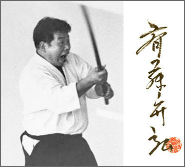When did you start Aikido and why?
It was sometime in mid 1981. I had moved to Cambridge and some friends of mine from South London had started doing Jujitsu. It sounded interesting and I felt I needed to be fitter than I was at the time. I thought that learning a martial art was a more useful way of getting fit than just going to a gym and I saw a beginner’s class advertised in the local paper. I hadn’t much of an idea what aikido was beyond that it was some kind of martial art. I recruited a friend of mine for moral support and off we went to the first lesson.
The class was taught by Tony Sargeant – who was a first Dan at the time, and Bob Jackson also a first Dan. The lesson was a combination of demo and being taught and practicing. I enjoyed it and kept going when my friend dropped out after a few weeks. I can recall looking at the green belts and thinking I could maybe get to be as good as they were, but didn’t think I would ever be as good as the Dan grades.
What are some of your main Aikido memories?
I have a lot of great memories from the training, the places and the people. However a lot of them fall into the “you had to be there” category. So to preserve you from tedium I will draw a veil over these, with the exception of one incident.
I walked into the changing room in the Howard Mallet Centre in Cambridge to find one of the students in a quandary. He was putting on a hakama for the first time and couldn’t work out how to fasten it. I demonstrated as I got changed, which he copied. Pleased with his success it wasn’t until he tried to go to the class that he realised he had put both legs down one leg-hole…
What are your personal goals in Aikido?
To better understand it and to transmit that understanding to anyone who wants to learn.
Why do you think Iwama Aikido is so unique?
In order to do this I will have to define what I think of as Iwama Style and in order to do that I will have to define what I understand to be Aikido.
Unfortunately Aikido has seemingly come to mean different things to different people and this is reflected in both how it is taught and how it is viewed by both practitioners and non-practitioners. What is beyond dispute is that O’Sensei learned Daito Ryu aiki jujutsu from Sokaku Takeda. O’Sensei then sought to simplify or rationalise the syllabus. In my view two complications now arise. The first is the meaning of “aiki”.
Aiki is usually translated to be harmony of spirit, which is often taken to mean being in harmony with your partner. This is often taken in a literal physical way that can lead to techniques being very cooperative on the part of the “attacker”. In classical martial arts aiki had to be broken as it would lead inevitably to stalemate or exhaustion. However it is thought that Sokaku Takeda used aiki to mean “internal power”, perhaps deliberately disguising the meaning or just using the words in a different context.
The second confusion comes from the way Aikido was demonstrated by O’Sensei. His filmed demonstrations are very different from how he taught in Iwama. A plausible explanation for this is that his demonstrations were actually a reflection or enaction of his religious beliefs into which he was involving the audience rather than a conventional martial arts demonstration.
Yet another complication occurs from the main Aikido (Hombu) dojo being in Tokyo where O’Sensei’s son and Tohei were the main teachers. There became a great deal of difference between aikido in Tokyo and Aikido in Iwama (O’Sensei’s home). Clear examples are the much greater use of weapons and a much greater emphasis on basic techniques in Iwama style. Since the Hombu was the main dojo the majority of today’s aikido is derived from that source. After O’Sensei’s death there were also further splits between his original students leading to other different styles.
Iwama style was used by Morihei Saito Sensei to distinguish what he claimed to be a more original style from other styles. Since I started this style has evolved and changed and now Hitohira Saito Sensei runs the Iwama dojo and he has also made significant changes.
In order to make sense of all the above and to give a consistent vision of how I teach and practice I have come to the following approach.
Aiki, to me means internal power and also harmony. However the harmony has to start within yourself and with your movements. Harmonising your body and mind in this way leads to internal power being available. I had now better define internal power. This to me is a product of movement and body structure. To put it as briefly and simply as I can; minimising the use of muscular force and aligning the body allows the whole musculoskeletal system to work as a whole which leads to increased power at much lower levels of effort and metabolic cost.
To move in a way that generates internal power is actually very simple, the barrier to learning is often our pre-conceived ideas of how our bodies’ function and a lack of proprioception.
To me therefore, combining internal power with techniques that work by fully controlling the opponent’s centre and the use of weapons as a route to internal power is the essence of Iwama style. The techniques when approached in this way then build into a logical and self-consistent system.
What can Aikido offer people in your opinion?
By training in the correct way one get some obvious benefits like exceptionally stable postures and strong structure combined with effective techniques, provided one takes a realistic view of the differences between a technique used for learning a principle and an applied technique; something that is not always appreciated.
Other than that studying almost anything can bring various benefits, and what you put in is proportional to what you get out. I’m not going to go into a list of positives here, as my list may well be different from others, but aikido is in itself is a worthwhile pursuit. Sometimes it is difficult and sometimes frustrating but always the benefits far outweigh the negatives.
The bottom line is that I can look back and say “I’m so glad I started doing this”.
How long have you been training?
A moving target! Think of the year today, go to the first question and find my start year, then take this number away from the number you first thought of to give the answer. Unless of course this has been printed somewhere as an obituary in which case you may have to juggle the numbers a bit more.
Where have you traveled?
I’ve done some travelling to train with various people but I find such listings rather uninteresting to read so I will spare you from a dull list.
Some philosophies claim that the world as we see it is entirely constructed within our minds, so in some way perhaps I have always been in the same place. If this is so then it is important to choose to make the best use of opportunities to learn wherever you believe yourself to be. Also try and make the place you live a better place – or at the very least not worse.



